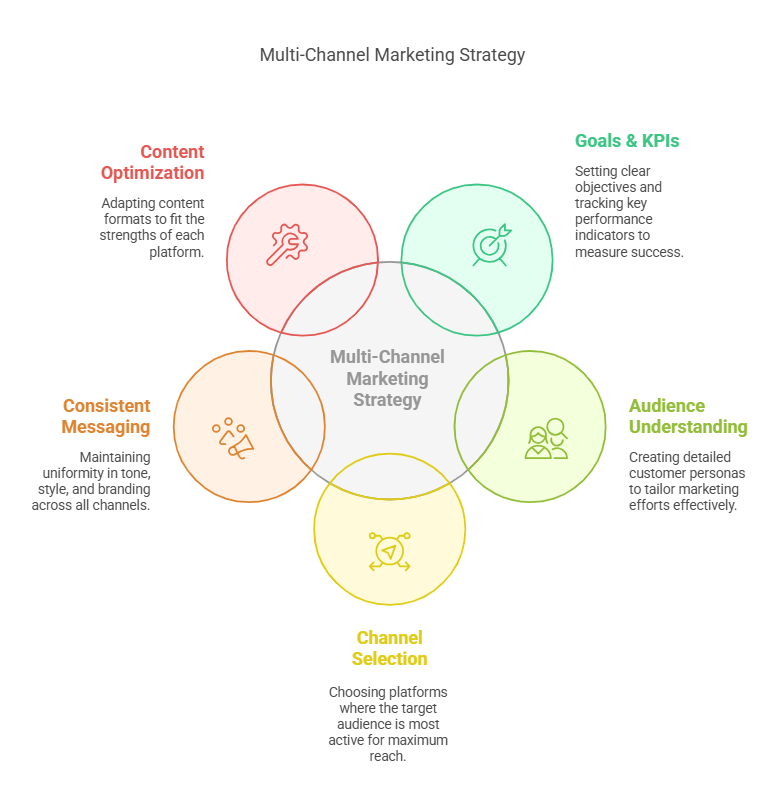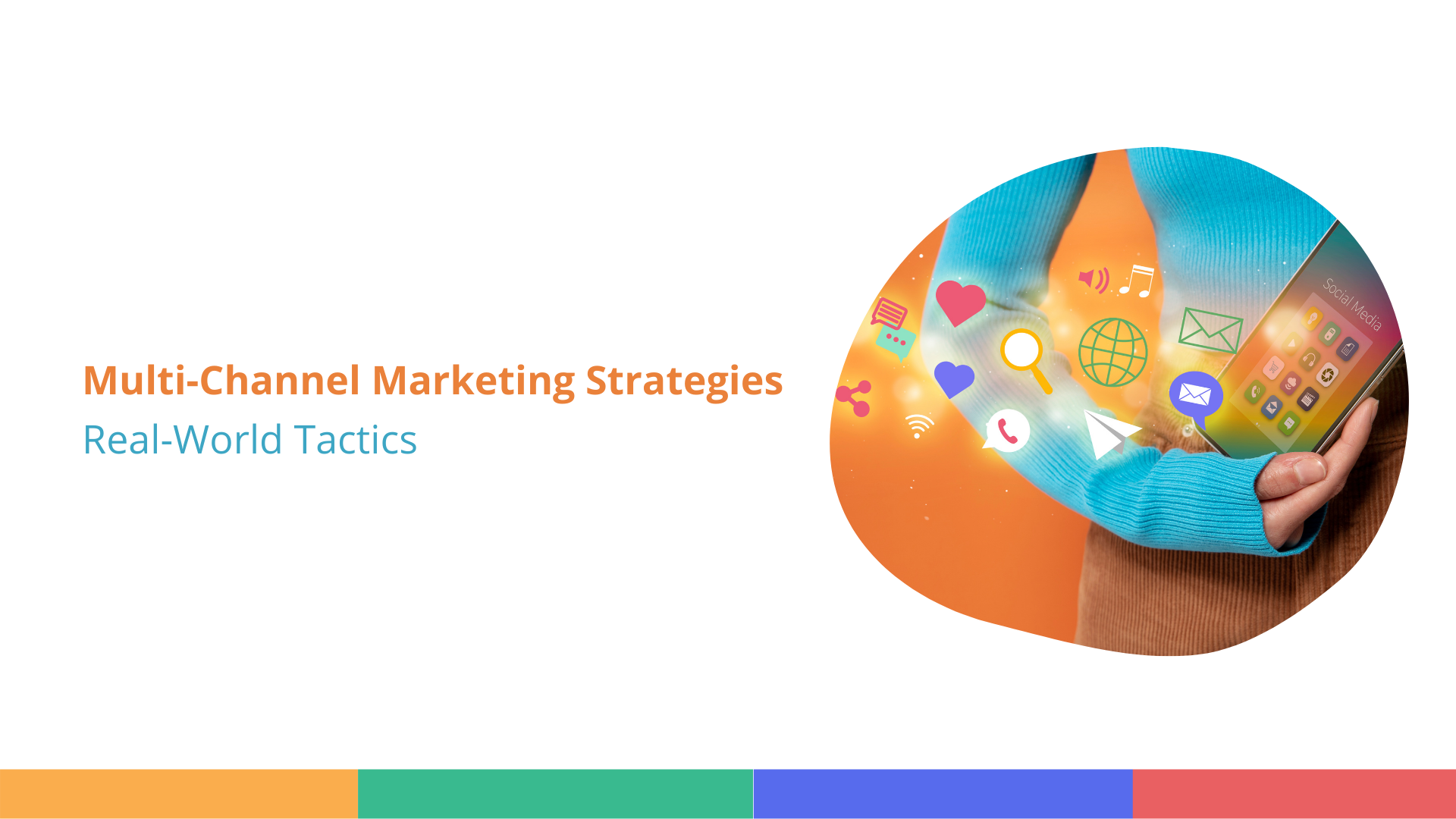In today’s digital world, reaching your customers isn’t as simple as having a website. Consumers use many different channels—social media, email, mobile apps, in-store visits, and even traditional advertising—to connect with brands. For small e-commerce businesses, this means you need multi-channel marketing strategies to be where your customers are. In this guide, we’ll explore what multi-channel marketing is, why it’s so important, and how to create and implement an effective strategy. We’ll use real-world examples, explain things in simple language, and dive into operational, day-to-day tactics that even a ninth grader can understand. So, let’s get started!
What Is Multi-Channel Marketing?
Multi-channel marketing is the practice of reaching customers through more than one channel. Imagine you’re trying to sell your favorite pair of sneakers. Instead of relying on just one method—say, your website—you could promote them on Instagram, send an email, use text messages, run ads on TV, and even have a pop-up store. Each channel has its own advantages, and together, they help you reach more people and offer a better shopping experience.
For example, if a customer sees your sneaker ad on Instagram and then receives an email with a special offer, they are more likely to visit your website and eventually make a purchase. This approach helps build a relationship with customers, making them feel understood and valued.
Why Is Multi-Channel Marketing Important?
When you use several channels to promote your products, you expand your reach. This means more people learn about your business, and you have a higher chance of turning visitors into loyal customers. But there’s more to it than just reaching a wider audience. Here’s why multi-channel marketing matters:
Increased Reach
By promoting your products on multiple channels, you can connect with customers who might not see your message if you only used one platform. For example, some people might spend more time on social media, while others might check their emails every day. Using both channels ensures you capture different segments of your target audience.
Improved Customer Experience
A multi-channel approach creates a smooth and consistent experience. Imagine you see an ad on Facebook, click through, and then receive a follow-up email that matches the message you saw. That consistency builds trust. It makes customers feel like your brand truly understands them and is ready to help, no matter how they choose to interact.
Better Data and Insights
When you market on multiple channels, you can gather a lot of data about how customers behave. You can learn which channels drive the most traffic, which ones lead to sales, and how customers interact with your brand. This data helps you improve your strategies over time.
Higher Conversion Rates
When customers interact with your brand on more than one channel, they are more likely to make a purchase. Multiple touchpoints—like a social media ad, a website visit, and a follow-up email—work together to guide customers through the buying process.
Competitive Advantage
Many small businesses still rely on a single channel, leaving a huge opportunity for those who adopt a multi-channel strategy. By engaging customers across various platforms, you can differentiate your brand from competitors and build a stronger, more recognizable presence.
The Evolution of Marketing Channels
Remember a few years ago, when marketing was all about print ads and TV commercials? Today, the options are almost endless. Digital technology has transformed marketing. Now, businesses can reach consumers through:
- Social Media: Platforms like Instagram, Facebook, TikTok, and Twitter let you connect in real time.
- Email: Personalized emails remain one of the most effective ways to nurture leads and build loyalty.
- Mobile Apps: Many customers shop on their phones. A mobile app can provide a personalized shopping experience.
- Websites: Your website is your digital storefront, offering detailed information about your products.
- In-Store Experiences: Physical stores still play a role, and when combined with digital elements, they offer a cohesive customer experience.
- Traditional Media: Radio, TV, and print still have their place, especially when combined with digital marketing.
The key is to integrate these channels so they work together, rather than in isolation. This means your messaging should be consistent, and your data should flow seamlessly between channels.
Real-World Examples of Multi-Channel Marketing
Example 1: Vrbo
Vrbo, a company that helps people book vacation rentals, uses a multi-channel marketing strategy to reach its audience. They maintain an engaging website, a mobile app, and active social media profiles. On Instagram, they share beautiful images and user-generated content like vacation photos. On their website, they use detailed listings and reviews. When a customer sees a stunning picture on social media, they are likely to click through to the website, read reviews, and book a stay. This coordinated strategy ensures that Vrbo stays top-of-mind and builds trust with potential customers.
Example 2: CVS
CVS, a well-known pharmacy chain, has seamlessly integrated its online and offline channels. Customers can use the CVS app to refill prescriptions, check product availability, and even chat with a pharmacist. Meanwhile, their in-store experience is closely aligned with the digital experience. For example, a customer might get a notification on their phone about a discount and then visit the store to pick up the discounted product. This approach creates a unified customer journey, ensuring that whether the interaction is online or offline, the customer gets the same level of service.
Example 3: Nike
Nike is another great example of multi-channel marketing. They use social media to launch product campaigns, email to notify customers of exclusive deals, and their website to offer in-depth product information and online shopping. Additionally, Nike’s mobile app integrates fitness tracking with shopping, creating a community of loyal users who are engaged across multiple channels. This approach not only drives sales but also builds a strong, emotionally connected brand.

How to Create an Effective Multi-Channel Marketing Strategy
Building a multi-channel marketing strategy might sound overwhelming, but breaking it down into manageable steps can make it much easier. Here’s a step-by-step guide:
1. Define Your Goals and KPIs
Start by asking yourself: What do you want to achieve? Is your goal to increase brand awareness, generate leads, or boost sales? Once you know your goal, set clear Key Performance Indicators (KPIs). For example, if you’re focusing on brand awareness, you might track social media engagement and website traffic. If sales are your goal, look at conversion rates and customer acquisition costs. Having clear goals helps you measure success and adjust your strategy when needed.
2. Understand Your Target Audience
Knowing your audience is the foundation of any successful marketing strategy. Create detailed customer personas that include information like age, gender, interests, shopping habits, and pain points. This helps you choose the right channels to reach them. For instance, if your target audience is teenagers, platforms like TikTok or Instagram might be more effective than email marketing. Understanding your audience also helps tailor your message to meet their specific needs.
3. Choose the Right Channels
You don’t have to be everywhere—choose the channels that your target audience uses the most. Analyze your customer data to find out where your potential customers spend their time. Focus on a few key channels initially rather than spreading yourself too thin. For example, if you find that most of your customers engage on social media and through email, start there and expand later as needed.
4. Create Consistent Messaging
Consistency is crucial for building trust. Your brand message should be uniform across all channels, even if the content is adapted to suit different platforms. Develop clear brand guidelines that include your tone, style, colors, and imagery. Whether a customer sees your ad on Instagram or receives an email, they should instantly recognize your brand. Consistent messaging strengthens your brand identity and makes your marketing efforts more effective.
5. Develop a Content Calendar
Planning your content is key to staying organized and ensuring that your messaging is timely and consistent. Create a content calendar that outlines what will be posted on each channel, when, and what the main message will be. This calendar helps you coordinate campaigns across different platforms and ensures that your marketing efforts are synchronized. Regularly update your calendar based on performance data and changing trends.
6. Implement Tracking and Analytics
To know what’s working and what’s not, you need to track your performance across all channels. Set up analytics tools like Google Analytics, social media insights, and email marketing dashboards to monitor key metrics such as engagement, conversion rates, and customer behavior. Analyzing this data will provide insights into which channels are driving the most traffic and conversions, helping you optimize your strategy over time.
7. Optimize for Each Channel
While your overall message should be consistent, the content itself needs to be tailored for each platform. For example, visual content is key on Instagram, while LinkedIn may require more professional, detailed posts. Customize your content to suit the strengths of each channel, and always test different formats to see what resonates best with your audience.
8. Integrate Online and Offline Experiences
For businesses that have both an online presence and physical locations, it’s important to bridge the gap between digital and in-store experiences. Use tools like QR codes on in-store displays that lead to online promotions, or offer click-and-collect services where customers can shop online and pick up in-store. This integrated approach provides a seamless customer journey and reinforces your brand across all touchpoints.
9. A/B Test and Refine Your Strategy
Experimentation is key. Use A/B testing to try out different messages, visuals, and content formats on your chosen channels. Monitor the results to see which versions perform best and adjust your strategy accordingly. Continuous testing and refinement help you stay ahead of trends and ensure that your marketing efforts are always optimized.
10. Review and Adjust Regularly
Finally, multi-channel marketing is an ongoing process. Regularly review your performance data and adjust your strategy based on what you learn. Look at the overall customer journey to identify any gaps or bottlenecks. For instance, if you notice that email open rates are dropping, it might be time to update your subject lines or content. Always be ready to pivot your strategy to keep up with changing customer behavior and market trends.
Real-World Success Stories
Let’s look at some practical examples of businesses that have successfully implemented multi-channel marketing strategies:
Vrbo’s Customer Journey
Vrbo, a vacation rental company, uses its website, mobile app, and social media to create a unified customer experience. When a user sees a beautiful vacation photo on Instagram, they’re drawn to Vrbo’s website, where detailed listings and user reviews build trust. Vrbo’s integrated approach across channels helps guide the customer from initial interest to booking a stay, ensuring a seamless journey.
CVS’s Integrated Strategy
CVS effectively combines its online and in-store experiences. Customers can manage prescriptions, chat with pharmacists, and receive personalized health notifications through their mobile app. Meanwhile, their physical stores are integrated with the digital experience, so customers receive consistent service whether they’re shopping online or in person. This integration not only boosts sales but also enhances customer loyalty.
Nike’s Multi-Channel Engagement
Nike excels at reaching its audience through a variety of channels. Their multi-channel strategy includes engaging social media posts, email newsletters, and a robust mobile app that tracks fitness goals while promoting new products. By tailoring content for each platform while keeping a consistent brand message, Nike builds a strong emotional connection with its customers and drives high conversion rates.
Common Challenges in Multi-Channel Marketing
Despite its benefits, multi-channel marketing comes with challenges:
Data Integration and Silos
When you use multiple channels, it’s easy for customer data to become fragmented. Without a centralized system, you might miss important insights into customer behavior. Investing in integrated analytics tools can help you get a full picture of your marketing performance.
Consistency Across Platforms
Maintaining a consistent brand voice and message across different channels is a major challenge. Each platform has its own style and audience, which can lead to mixed messages. Clear brand guidelines and centralized content management systems are essential for overcoming this issue.
Resource Allocation
Running campaigns across multiple channels can be resource-intensive. For small businesses, it’s important to focus on the platforms that yield the best results and to use automation tools to manage repetitive tasks. Starting with a few key channels before expanding can help you manage your resources effectively.
Measurement and Attribution
With many channels at play, tracking which efforts lead to conversions is complicated. It requires robust analytics and a clear attribution model to understand the impact of each channel on your overall strategy. This helps you optimize your marketing spend and efforts.
FAQs on Multi-Channel Marketing
Q: What is multi-channel marketing?
A: It’s the strategy of using multiple channels—online and offline—to engage customers and drive sales. This could include social media, email, mobile apps, physical stores, and more.
Q: How is it different from omnichannel marketing?
A: Multi-channel marketing uses various channels independently, while omnichannel marketing creates a seamless, integrated experience across all channels.
Q: What are the benefits of multi-channel marketing?
A: Benefits include increased reach, better customer engagement, improved data insights, higher conversion rates, and a competitive advantage.
Q: How can small businesses start with multi-channel marketing?
A: Begin by identifying the channels where your target audience is most active, create a content calendar, and use automation tools to manage campaigns efficiently.
Q: What are the common challenges?
A: Challenges include data silos, maintaining consistency, resource allocation, and tracking performance across channels.
Final Thoughts
Multi-channel marketing is essential for modern e-commerce success. By embracing a strategy that spans various channels—from social media and email to mobile apps and physical stores—you can create a cohesive customer experience that drives engagement, builds loyalty, and boosts sales.
Remember, the goal is not to be everywhere at once, but to be consistently present where your audience is. Focus on quality over quantity, tailor your messaging for each channel, and use data to refine your approach continuously. The right multi-channel strategy can transform your marketing efforts into a powerful engine for growth.
Whether you’re just starting out or looking to take your online business to the next level, implementing these actionable strategies will help you connect with your audience, understand their needs, and ultimately, convert them into loyal customers. Embrace the challenge, test your ideas, and keep optimizing—because in today’s competitive landscape, a well-executed multi-channel marketing strategy is the key to lasting success.
Now, what channels are you prioritizing for your marketing strategy, and how do you plan to overcome the challenges? Share your thoughts and let’s get the conversation started!




